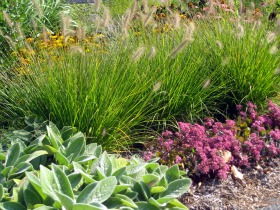
Hameln dwarf fountain grass makes a fine companion to lamb's ears, sedum, purple coneflower and rudbeckia in my fall garden.
Ornamental Grasses for Small Spaces
While I love the color, texture, and movement that ornamental grasses bring to the landscape, many are too large for my modestly sized gardens. Also some of the grasses tend to get floppy, especially when they're weighted down with fall rains. Fortunately there are some excellentchoices that won't overwhelm a small space.
One of my favorites is 'Hameln' dwarf fountain grass (Pennisetum alopecuroides 'Hameln'), with its small size and erect habit. It's fine-textured, bright green, arching foliage makes a nice backdrop for blooming plants early in the season. Then in late summer the bottlebrush-shaped, buff
colored flower heads emerge, looking so soft you want to stroke them. As the weather cools, the leaves take on shades of gold, eventually turning a soft tan. Growing in clumps 18-24 inches tall and wide, dwarf fountain grass does best in full sun and well-drained soil. While many sources list it as hardy in zone 5-9, mine have prospered unprotected for several years in my zone 4 garden.
If you need an even smaller grass, try the adorably named 'Little Bunny' dwarf fountain grass. Reaching only about one foot tall and wide, the creamy flowers of this diminutive grass look like -- you guessed it -- little bunny tails as they sway in the breeze above an arching mound of green leaves, beginning in late summer and continuing into fall.
Both these grasses looked great in massed plantings and combine well with flowering perennials such as rudbeckia and purple coneflower. In my garden, these two perennials rise in back of a planting of 'Hameln' fountain grass, while fuzzy, gray-green lambs ears and purple-pink 'Vera Jameson' sedum skirt the front. It makes a stunning picture in late summer and fall!
Another excellent choice for small spaces is 'Elijah Blue' blue fescue (Festuca cinera 'Elijah Blue'). Growing only about 8 inches tall in arching tufts of semi-evergreen, powdery blue foliage, this grass makes a neat edging and combines well with low sedums. In midsummer, buff-colored seed heads wave on 12-14 inch stalks above the foliage. It is rather short-lived, needing division every few years to keep it vigorous, but is otherwise pretty carefree.
If you have room for a little bit larger grass, little bluestem (Schizachyrium scoparium) is a nice choice. Growing only 2-3 feet tall, it is in scale with many flowering perennials. I grow the cultivar 'The Blues' with intense, metallic blue foliage that turns to shades of copper and burgundy as
the weather cools in fall, along with pinkish flowers in late summer that develop into soft white seed heads. I grow mine near the late summer-flowering hardy mum 'Clara Curtis,' whose pink blossoms pick up the rosy tones of this grass in fall.
All of these grasses do best in full sun and well-drained soil and are drought-tolerant once they are established. Left standing over the winter, these grasses provide winter interest and food for birds. Cut back the old foliage in the spring before new growth begins.
Views: 12
© 2025 Created by Aggie.
Powered by
![]()